

The Death Of Expertise. I am (or at least think I am) an expert.

Not on everything, but in a particular area of human knowledge, specifically social science and public policy. Sloppy Citations of 1980 Letter Led To Opioid Epidemic, Researchers Say : Shots - Health News. A 1980 letter published in the New England Journal of Medicine was later widely cited as evidence that long-term use of opioid painkillers such as oxycodone was safe, even though the letter did not back up that claim.
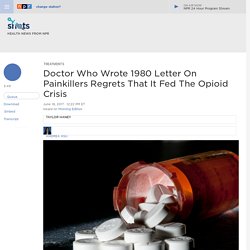
Education Images/UIG via Getty Images hide caption toggle caption Education Images/UIG via Getty Images. Evaluating Sources in a ‘Post-Truth’ World: Ideas for Teaching and Learning About Fake News. Back in 2015, when we published our lesson plan Fake News vs. Real News: Determining the Reliability of Sources, we had no way of knowing that, a year later, the Oxford Dictionaries would declare “post-truth” the 2016 word of the year; that fake news would play a role in the 2016 presidential election; that it would cause real violence; and that the president-elect of the United States would use the term to condemn mainstream media outlets he opposes. Back then, to convince teachers that the skill was important, we quoted Peter Adams of the News Literacy Project on the “digital naïveté” of the “digital natives” we teach.
New Yorker cartoon by @JoeDator. Checkology Ten Questions for Fake News Detection. Craig Silverman's 6 steps to spot fake news. These 6 Easy Steps Will Help You Spot Fake News Every Time. Fake News Antidote: Teaching Kids To Discern Fact From Fiction : NPR Ed. By now, you've probably heard about one very real consequence of fake news — the infamous "pizzagate" conspiracy theory that ended with Edgar Welch, 28, firing a real gun inside a real Washington, D.C., pizzeria filled with real people.
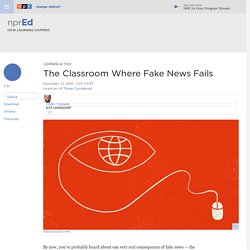
When The New York Times later asked Welch what he thought when he realized there were no child slaves inside the restaurant, as one fake news story had led him to believe, he responded: "The intel on this wasn't 100 percent. " Welch isn't the only one struggling to tell fact from fiction in this digital age. A recent Stanford study found that America's middle, high school and college students are shockingly bad at it, too. Quiz: Can You Spot the Fake News Story? In the age of digital information overload and the current divisive climate in the United States, discerning whether information you read is fact-based or fake can be tricky.
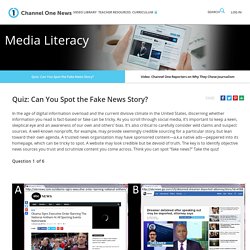
As you scroll through social media, it’s important to keep a keen, skeptical eye and an awareness of our own and others’ bias. It’s also critical to carefully consider wild claims and suspect sources. Information Literacy and Fake News. ACRLog welcomes a guest post from Candice Benjes-Small, Head of Information Literacy and Faculty Outreach, and Scott Dunn, Associate Professor of Communication, at Radford University.
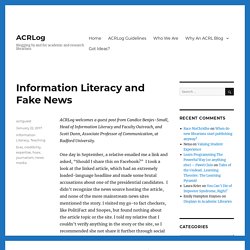
One day in September, a relative emailed me a link and asked, “Should I share this on Facebook?” I took a look at the linked article, which had an extremely loaded-language headline and made some brutal accusations about one of the presidential candidates. I didn’t recognize the news source hosting the article, and none of the more mainstream news sites mentioned the story. I visited my go-to fact checkers, like PolitiFact and Snopes, but found nothing about the article topic or the site.
I told my relative that I couldn’t verify anything in the story or the site, so I recommended she not share it further through social media. Truth, truthiness, triangulation: A news literacy toolkit for a “post-truth” world. We were guaranteed a free press, We were not guaranteed a neutral or a true press.
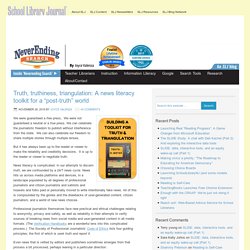
We can celebrate the journalistic freedom to publish without interference from the state. We can also celebrate our freedom to share multiple stories through multiple lenses. But it has always been up to the reader or viewer to make the reliability and credibility decisions. It is up to the reader or viewer to negotiate truth. News literacy is complicated. Professional journalists themselves face new practical and ethical challenges relating to anonymity, privacy and safety, as well as reliability in their attempts to verify sources of breaking news from social media and user-generated content in all media formats. Research and an infographic about research. Infographics are viral.
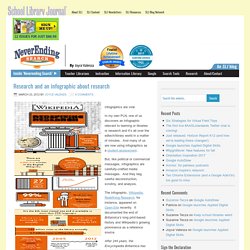
In my own PLN, one of us discovers an infographic relevant to learning or libraries or research and it’s all over the edtech/library world in a matter of minutes. And many of us are now using infographics as a student assessment. Teaching Information Literacy Now. Last week, a new study from Stanford University revealed that many students are inept at discerning fact from opinion when reading articles online.
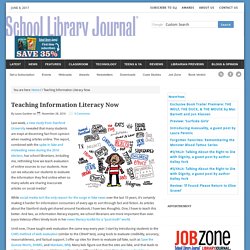
The report, combined with the spike in fake and misleading news during the 2016 election, has school librarians, including me, rethinking how we teach evaluation of online sources to our students. How can we educate our students to evaluate the information they find online when so many adults are sharing inaccurate articles on social media? While social media isn’t the only reason for the surge in fake news over the last 10 years, it’s certainly making it harder for information consumers of every age to sort through fact and fiction. As articles about the Stanford study get shared around Facebook, I have two thoughts.
One, I have to teach this better. In follow-up lessons, we use the CARS strategy to evaluate other websites in order to rank their usefulness.